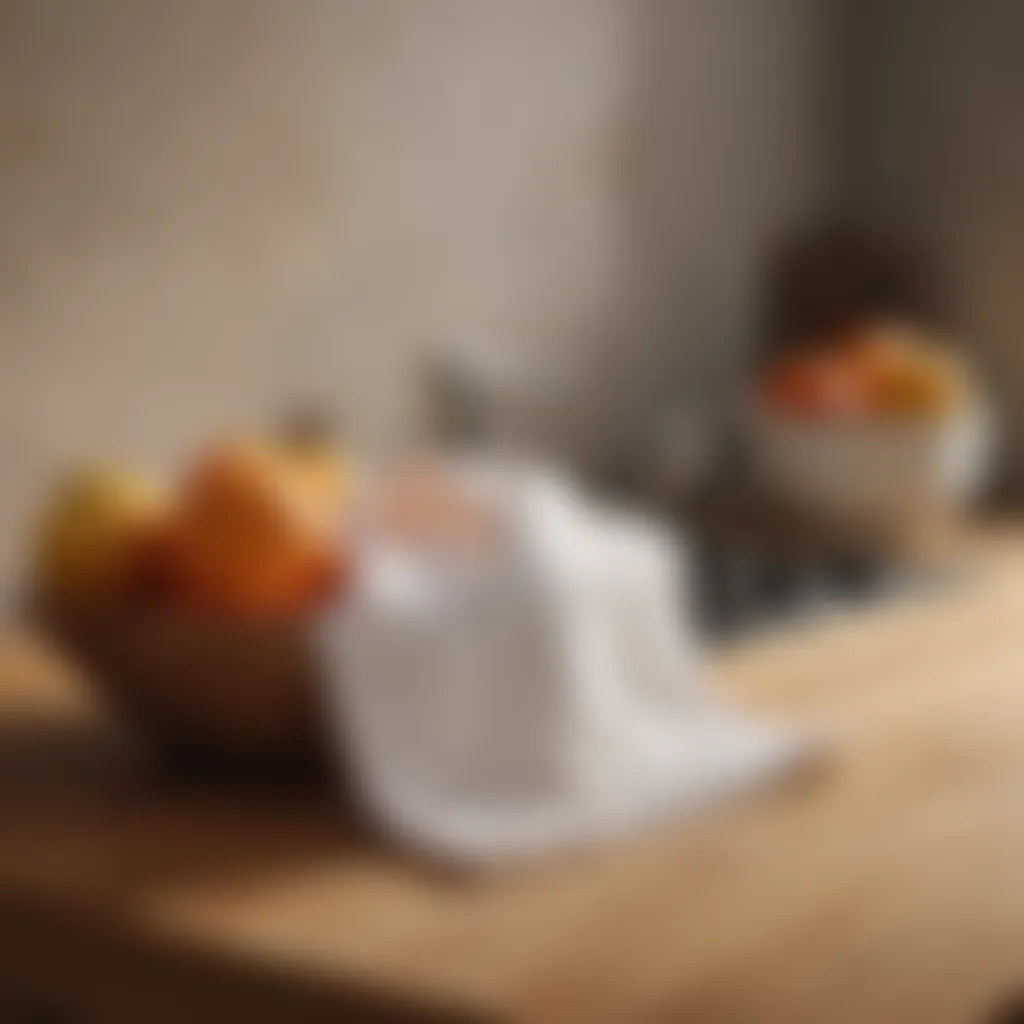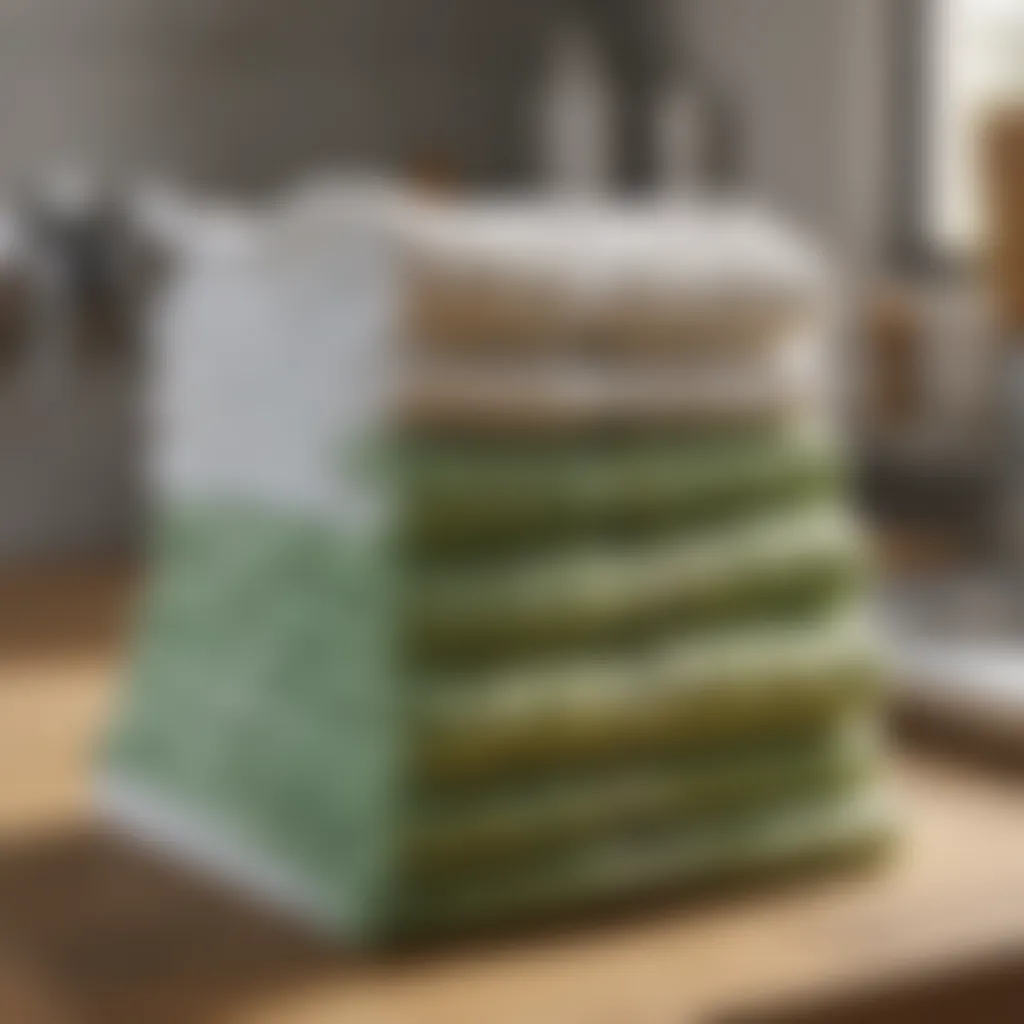Exploring the Dual Role of Dish Drying Towels


Intro
Dish drying towels serve a critical function in every kitchen. While their primary role is to absorb moisture and dry dishes, they also bring aesthetic value to the space. Their material, design, and size can complement various kitchen themes and styles. Considering the blend of functionality and aesthetics is essential for anyone, especially for housewives, who often spend considerable time in the kitchen.
This article will explore the different aspects of dish drying towels, from the materials used in their production to their sustainable practices and the role they play in reinforcing kitchen decor.
Ingredients:
When selecting dish drying towels, it is the materials that help define their practical and visual appeal. Here are some key ingredients that contribute to their overall value:
- Cotton: Naturally absorbent and soft, cotton towels are a kitchen staple. They come in various densities and weights.
- Linen: Known for its durability and quick-drying properties, linen towels offer a refined elegance to any kitchen.
- Microfiber: This synthetic option excels in absorbency and is often used for quick drying and cleaning tasks.
- Bamboo: An eco-friendly material, bamboo towels are highly absorbent and possess antibacterial properties.
Sizes also matter. Standard sizes typically range from 15x25 inches to 18x28 inches, accommodating different drying needs.
Preparation Steps:
The selection process for the right towels involves these steps:
- Identify Usage: Determine the primary usage. Will they be used for drying dishes, wiping spills, or both?
- Select Material: Based on the identified use, choose a suitable material that aligns with your needs and lifestyle.
- Choose Design: Consider colors and patterns that will harmonize with your kitchen's decor. This step can significantly enhance the visual aspect.
- Purchase Quantity: It is wise to have several towels on hand to ensure cleanliness and usability.
Technical Aspects:
When considering towel effectiveness, several technical aspects come into play:
- Temperature Settings: For washing towels, hot water settings (around 60°C or 140°F) work well for cotton and linen to remove bacteria and stains effectively.
- Drying Time: Microwaving damp towels for 1-2 minutes can quickly disinfect and freshen them; however, always check care labels.
- Critical Techniques: Proper folding and storage of towels can prevent germs. Storing them in a dry place is also crucial to maintain their longevity.
Cooking Process:
While the term "cooking" applies in a general sense, managing kitchen textiles properly is essential. Follow these actions:
- Wash Before Use: Wash new towels to enhance their absorbency and remove any factory residues.
- Use Correctly: Avoid using towels for both drying dishes and cleaning surfaces to minimize cross contamination.
- Rotate Usage: Have multiple towels in rotation to help with hygiene. Use one type for dishes and another for surfaces.
Troubleshooting Tips:
Encountering issues is common when using dish drying towels. Here are solutions for frequent challenges:
- Stains and Odors: For stains, use a diluted vinegar solution as a pre-soak. It can also neutralize odors.
- Poor Absorbency: If absorbency declines, wash the towels in hot water without fabric softener. This helps to restore their wicking abilities.
- Fraying Edges: For towels showing wear, determine if a straight stitch on a sewing machine can prolong their life.
Remember, dish drying towels not only function as drying implements but also as decor elements in your kitchen. Choosing wisely will make a significant difference in both usability and aesthetic appeal.
Preamble to Dish Drying Towels
Dish drying towels are deceptively simple, yet pivotal in kitchen functionality and style. These items play an essential role in maintaining cleanliness and supporting daily cooking routines. More than just absorbent fabrics, they are integral to a well-organized and aesthetically pleasing kitchen. Understanding their functions helps in making informed choices in the kitchen care arsenal.
Definition and Purpose
Dish drying towels refer to cloths specifically designed to assist in drying dishes, utensils, and other kitchen items after washing. Their primary function is absorbency, allowing moisture to evaporate quickly and efficiently. However, their purpose extends beyond mere practicality. They can also serve as decorative elements, adding warmth and personality to the kitchen space. When chosen wisely, these towels can complement the overall decor while being functional tools in everyday chores.
A quality dish drying towel should exhibit good moisture retention. Cotton towels are popular for this reason, but microfiber and linen options are also available, each offering unique benefits. When selecting a towel, consider both its absorbent properties and how it can enhance your kitchen's visual appeal.


Historical Context
Historically, drying towels have roots in domestic practices dating back centuries. Initially, simple cloths were used in homes to wipe away moisture from wooden utensils or clay dishes. As kitchen practices evolved alongside technological advancements, the materials and designs of dish drying towels changed.
In the 20th century, the introduction of synthetic fibers revolutionized these utensils. The convenience and performance of materials like microfiber became favorable among many households. Furthermore, cultural influences often dictate the design and usage of these towels; for instance, in various regions, towels portray traditional artistry or regional colors, reflecting local heritage. This evolution highlights that dish drying towels have always served both a functional and cultural role in the kitchen.
Material Considerations
When selecting dish drying towels, the choice of material plays a decisive role in their overall performance and appeal. Each material brings distinct properties, influencing aspects like absorbency, durability, and even aesthetic compatibility with kitchen decor. This section aims to outline the significant materials commonly used in dish drying towels, namely cotton, microfiber, and linen. Understanding these differences can help in making informed decisions tailored to individual kitchen needs.
Cotton
Cotton is arguably the most prevalent material for dish drying towels, prized for its robust absorbency and softness. These towels can effectively soak up water, making them ideal for drying dishes quickly after washing. The natural fibers of cotton allow for excellent air circulation, helping the towels dry faster than synthetic alternatives. This feature minimizes the development of bacteria or foul odors, a common concern with damp kitchen textiles.
In addition to functionality, cotton towels are available in various weaves and thicknesses. Examples like terry cloth and flour sack styles cater to different drying needs. While terry cloth offers a plush texture suitable for heavier tasks, flour sack towels are ultra-thin and expedite drying time due to their lightweight nature.
However, one must consider the potential for shrinking when washed, especially if subjected to high temperatures. Using mild detergent and air drying can help preserve their structural integrity.
Microfiber
Microfiber towels present a contrasting option to cotton, offering unique advantages. These are made from synthetic fibers, typically polyester and polyamide, which are exceptionally fine. Microfiber towels are highly absorbent, often outperforming traditional materials in their ability to wick moisture away. Their fine filaments can hold up to seven times their weight in water, providing remarkable efficiency in drying tasks.
Another notable benefit is that microfiber towels are less likely to leave streaks or lint behind, making them particularly appealing for those who value a pristine finish. Due to their construction, they also dry quickly, which mitigates any issues with bacteria growth.
It is worth noting, however, that microfiber must be cared for properly to maintain its effectiveness. Avoid fabric softeners and high heat while drying, as these can compromise the structure of the fibers. Regular washing on a gentle cycle helps retain the material's properties.
Linen
Linen, derived from the flax plant, is another viable material for dish drying towels. While linen is not as common as cotton or microfiber, it brings a distinct allure and practicality. This fabric is known for its strong absorbency and quick-drying capabilities, making it functional for drying dishes and other kitchen tasks.
Linen towels also exhibit remarkable durability, often becoming softer and more absorbent with each wash. Their natural fibers excel in moisture-wicking, effectively managing excess water without becoming saturated. Moreover, linen towels add a touch of elegance and sophistication to the kitchen, available in various colors and designs that can enhance the aesthetic of any space.
One aspect to consider, however, is the potential roughness of linen compared to cotton. Initially, it might feel coarse, but repeated washing softens the fabric significantly. Linen can also be more expensive, which may make it less accessible for some households.
Design and Aesthetic Options
The design and aesthetic options of dish drying towels play a significant role in both their functionality and their contribution to kitchen decor. When homeowners select towels, they often consider not only how well these items absorb water but also how they fit into the overall style of the kitchen. A well-chosen dish drying towel can enhance the visual appeal of a space while serving practical uses. It can harmonize with existing color schemes or serve as a statement piece in a more neutral environment.
This section discusses key aspects of design choices available when choosing dish drying towels. Patterns, colors, size variations, and seasonal themes all contribute to the overall effectiveness and enjoyment of these household items. The ability to balance practicality with visual enjoyment asserts the true value of dish drying towels in modern kitchens.
Patterns and Colors
Patterns and colors can significantly impact the aesthetic value of dish drying towels. A wide variety of options exist, ranging from classic checkered to bold florals. Selecting the right pattern can either complement the kitchen's existing decor or create a striking focal point.
Colors also play a vital role. Choosing neutral tones may allow the towel to blend seamlessly with other kitchen items, fostering a calm atmosphere. On the other hand, vibrant colors can energize the design.
For homeowners seeking to refresh their kitchen’s look without extensive renovations, changing dish drying towels can bring fresh life into the space.
"The right pattern and color can elevate kitchen aesthetics while fulfilling practical needs."


Size Variations
Size variations in dish drying towels are essential considerations when making a purchase. They can vary extensively, catering to different tasks and preferences. Standard sizes work well for everyday drying tasks, but larger towels might be necessary for handling pots or pans.
It is helpful to have various sizes on hand. For example, a small towel may be ideal for wiping up spills, while a larger one is perfect for drying larger dishes or even covering dough during rising. This layered approach allows for versatility in kitchen tasks. Additionally, having a range of sizes ensures that there is a suitable option for every drying need, which can reduce frustration in busy cooking moments.
Seasonal and Thematic Designs
Seasonal and thematic designs offer an exciting way to change the ambiance of a kitchen. With every season, new designs emerge that reflect festive occasions or natural motifs. For instance, holiday-themed dish drying towels can bring joy during festive cooking times. Spring motifs, like flowers or pastel colors, can inject freshness into the space.
Thematic designs allow for personal expression in the kitchen. Homeowners can choose towels that resonate with their interests, such as baking or gardening. This not only enhances the aesthetic appeal but also adds a layer of personal connection to the daily kitchen routine.
Functionality in Everyday Use
Understanding the functionality of dish drying towels is essential for anyone who values an efficient kitchen space. Not only do these towels serve a practical purpose in drying dishes, but they also embody an intersection of utility and design. Their roles extend into multiple aspects of daily kitchen routines, making them an indispensable part of household management.
Absorbency and Drying Time
When selecting dish drying towels, absorbency is a critical factor. A towel that can absorb liquid effectively ensures that your dishes dry quickly and efficiently. Options like cotton and microfiber are particularly renowned for their absorbent qualities. For instance, cotton towels can hold up to 27 times their weight in water, making them particularly useful after washing numerous dishes at once. On the other hand, microfiber towels dry off quickly themselves, reducing the risk of bacteria growth. The drying time of the towel itself is another consideration. A towel with quicker drying time is less likely to develop unpleasant odors. Thus, when you choose a towel, considering both its absorbency and how fast it dries contributes to maintaining hygiene in the kitchen.
Durability and Longevity
Durability is a significant aspect that cannot be overlooked. A high-quality dish drying towel is an investment that pays dividends over time. Choosing towels made from resistant materials like linen, which is known for its robust nature, ensures they withstand regular washing without losing form or function. In contrast, some cheaper towels tend to fray, discolor, or lose their absorbency after a few washes. Look for towels with reinforced edges as they tend to be more durable than those without. Purchasing towels that exhibit longevity means encountering fewer malfunctions during daily tasks. Replacements should not be a frequent concern. Careful selection based on durability will optimize long-term kitchen efficiency.
Multipurpose Uses Beyond Dishes
Dish drying towels offer multipurpose capabilities that many may overlook. Apart from drying dishes, they serve various functions in the kitchen. Here are some uses:
- Covering Rising Dough: Using a damp towel to cover dough while it rises creates the perfect environment, preventing drafts.
- Cleaning Surfaces: These towels can double up as excellent cleaning cloths for wiping spills on countertops.
- Handling Hot Cookware: Depending on the material, some can safely hold hot pots and pans.
- Table Settings: They can also add a touch of elegance when folded nicely and used as part of a table setting.
The versatility of dish drying towels appeals to those who seek to maximize functionality within their kitchen. By recognizing their multiple roles, one can allocate time and resources more efficiently, enhancing the overall cooking experience.
"A well-chosen dish drying towel is not only functional but also enriches your kitchen space."
In summary, the functionality of dish drying towels encapsulates a blend of absorbency, durability, and versatility, enhancing both everyday tasks and the aesthetic presence of the kitchen.
Care and Maintenance
Care and maintenance are crucial aspects of ensuring the longevity and effectiveness of dish drying towels. Proper care not only extends their usability but also preserves their aesthetic appeal. The attention given to these towels directly influences their functionality, meaning that how they are washed, stored, and assessed for wear can greatly impact their role in your kitchen.
Washing and Drying Recommendations
To maintain the quality of dish drying towels, washing and drying them correctly is essential. Here are some key points for washing:
- Use Gentle Detergent: Selecting a mild detergent helps preserve fibers while effectively cleaning the towels. Avoid products with bleach as they can degrade the fabric over time.
- Separate Colors: Mix colored and white towels with caution to prevent color bleeding. Sorting by color safeguards the original brightness of the towels.
- Wash in Warm Water: A warm wash can eliminate bacteria and food residues without making the fabric stiff or causing shrinkage. However, follow the manufacturer's recommendations if they specify a certain washing temperature.
For drying, the following tips are beneficial:
- Air Dry When Possible: Natural air drying minimizes wear from the heat of a dryer. It also helps release any lingering odors.
- Use Low Heat Setting: If using a dryer, select a low heat setting to protect the fibers. High heat can lead to shrinkage and loss of absorbency.


"Proper washing and drying techniques can significantly lengthen the life of your dish drying towels while maintaining their aesthetic quality."
Storage Solutions
After washing, proper storage of dish drying towels is vital. How these towels are stored can impact both their availability and their lifespan.
- Keep in a Dry, Ventilated Space: Storing towels in a dry area prevents mildew and odors. A kitchen drawer, drying rack, or dedicated towel holder can be ideal spots.
- Fold Neatly: Folding towels neatly helps maintain their shape and prevents creasing. Stack them vertically to easily access them when needed.
- Designating a Specific Place: Assigning a specific place for the towels in the kitchen can ensure they are always within reach. This habit promotes organization and efficient kitchen workflow.
Signs of Wear and Replacement Guidelines
Recognizing when to retire a dish drying towel is equally important as maintaining it. Below are signs that a towel may need replacement:
- Visible Damage: Look for frays, holes, or significant wear. These not only affect functionality but can also represent a hygiene risk.
- Reduced Absorbency: If towels feel less absorbent or leave streaks on dishes, it may signify breakdown in the fabric. Testing absorbency is simple and effective—just place a few drops of water on the towel. If it beads up and does not soak in, it is time for a new towel.
- Persisting Odors: Even after washing, if towels carry persistent odors, it might be a signal to replace them. Bacteria can cling to fabric over time, making thorough cleaning less effective.
Regular inspection and mindful maintenance of your dish drying towels enhance both their functional and aesthetic value in your kitchen.
Environmental Impact
The environmental impact of dish drying towels is an important consideration in this article. As households strive to reduce their ecological footprints, understanding how dish drying towels can contribute to sustainability becomes essential. This discussion centers on two critical components: the choice of materials and practices for reducing waste.
Sustainable Materials and Practices
When selecting dish drying towels, opting for sustainable materials can significantly reduce environmental impact. Towels made from organic cotton, for instance, are free from harmful pesticides and chemicals. These cotton towels not only provide excellent absorbency but also biodegrade more easily than synthetic alternatives like polyester.
Additionally, choosing towels that use eco-friendly dyes and finishes helps to minimize chemical runoff during production. Microfiber is another material that has gained popularity, but one must be cautious. While microfiber is durable and effective at cleaning, it is primarily derived from plastics. Hence, its production contributes to microplastic pollution when washed. Household practices also play a role. Here are some practices to consider:
- Use of Reusable Towels: Instead of disposable paper towels, maintaining a supply of reusable dish drying towels helps decrease waste.
- Washing Efficiently: Washing towels in full loads using cold water and mild detergents can lower energy use and chemical output.
- Air Drying: Utilizing a line or rack to dry towels instead of a dryer minimizes energy consumption.
Reducing Waste in the Kitchen
In a kitchen setting, the choice of dish drying towels can directly influence waste management. The emphasis on reducing waste extends beyond just choosing the right material. It involves implementing habits that promote longevity and utility.
- Multipurpose Usage: Towels can be used for various tasks beyond drying dishes, such as wiping surfaces or wrapping food, thus maximizing utility and reducing the need for additional products.
- Regular Maintenance: By caring for towels properly—washing them regularly and replacing them only when necessary—households can prevent unnecessary waste. A well-maintained towel can last for years, contributing to a reduction in consumption.
- Composting and Recycling: At the end of their life cycle, worn-out towels made from natural fibers can be composted, returning nutrients to the soil instead of ending up in landfills.
By choosing sustainable materials and practicing waste reduction, households can make a significant positive impact on the environment while enjoying functional and aesthetic dish drying towels.
Choosing dish drying towels wisely supports a more responsible approach to kitchen management. The movement towards eco-conscious living and sustainable choices starts in our kitchens, where every small action counts.
Finale
The conclusion of this article encapsulates the multifaceted role of dish drying towels in enhancing both functionality and aesthetics within the kitchen. Dish drying towels may seem like simple tools, yet they hold significant potential in shaping the kitchen experience. They are not just items to absorb water; they serve broader purposes that contribute to the overall kitchen environment.
Recapitulation of Key Insights
To summarize, dish drying towels come in various materials such as cotton, microfiber, and linen. Each material has distinct properties that affect absorbency, durability, and the ease of care. The aesthetic aspect includes an array of designs and colors that can complement kitchen decor, reflecting personal style as much as functionality. The towels are not restricted to drying dishes. They can be effectively used in various situations like handling hot cookware or even as decorative elements in serving. Therefore, their role extends far beyond an one-dimensional function.
"A well-chosen dish drying towel can elevate the kitchen's visual appeal while offering practical benefits."
Additionally, maintaining these towels requires attention to their care recommendations, which ensures longevity and cleanliness. Proper storage solutions and being aware of signs of wear can help in maintaining their effectiveness and appearance.
Final Thoughts on Dish Drying Towels
In final reflection, dish drying towels are essential tools in the kitchen that combine practical and aesthetic values. Their benefits range from improved drying capabilities to enhancing the kitchen's overall look. The focus on sustainable materials reflects a growing awareness of eco-friendly practices, allowing households to integrate responsibility into their daily routines.
As a housewife or domestic figure, understanding the importance of choosing the right dish drying towel can lead to a better kitchen experience. A thoughtful selection considers both daily practicality and aesthetic enhancement. Investing in quality towels not only improves efficiency while cooking but also enriches daily life with a touch of elegance.







